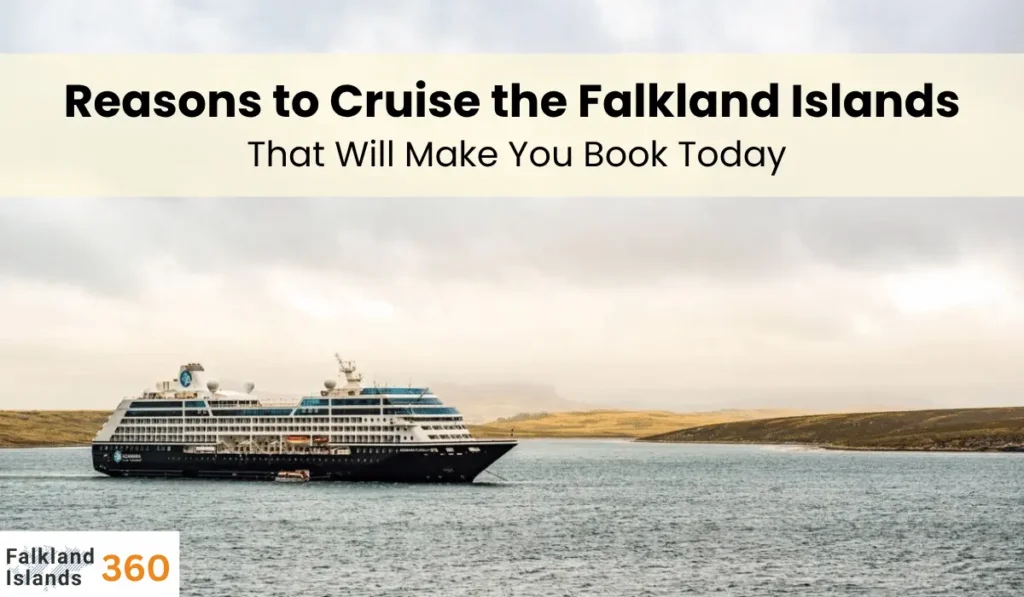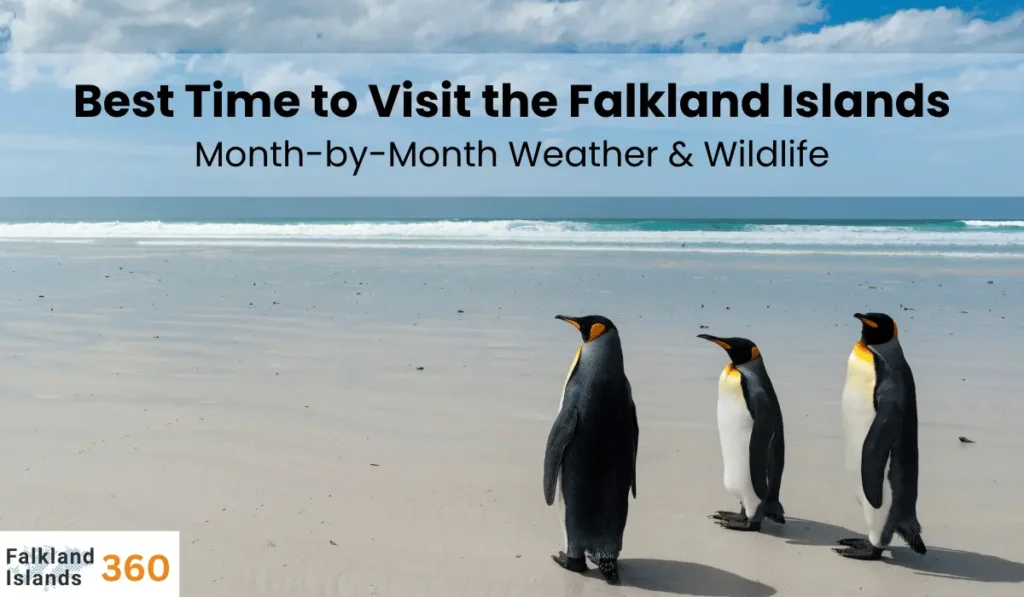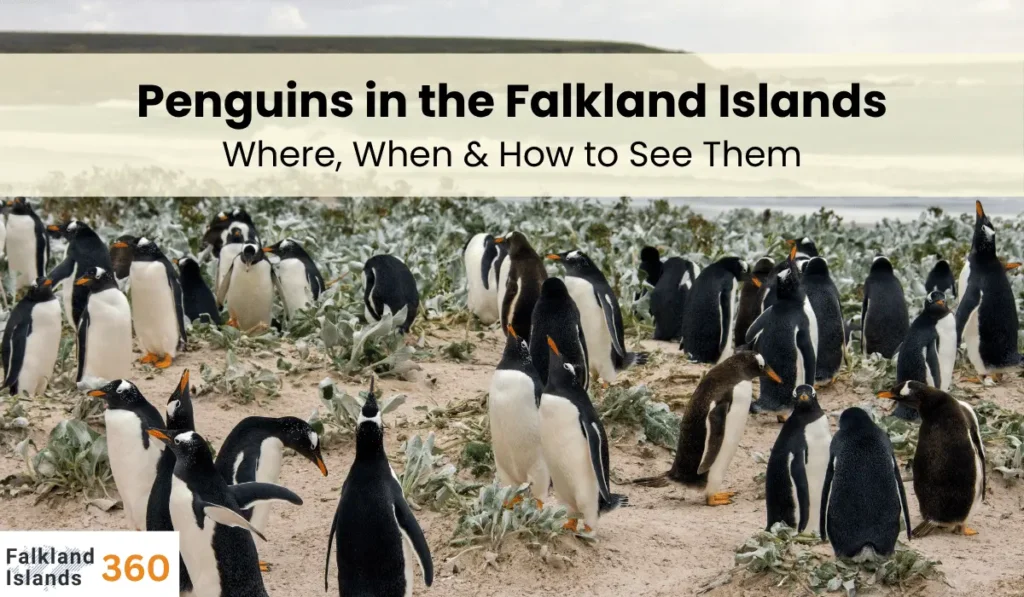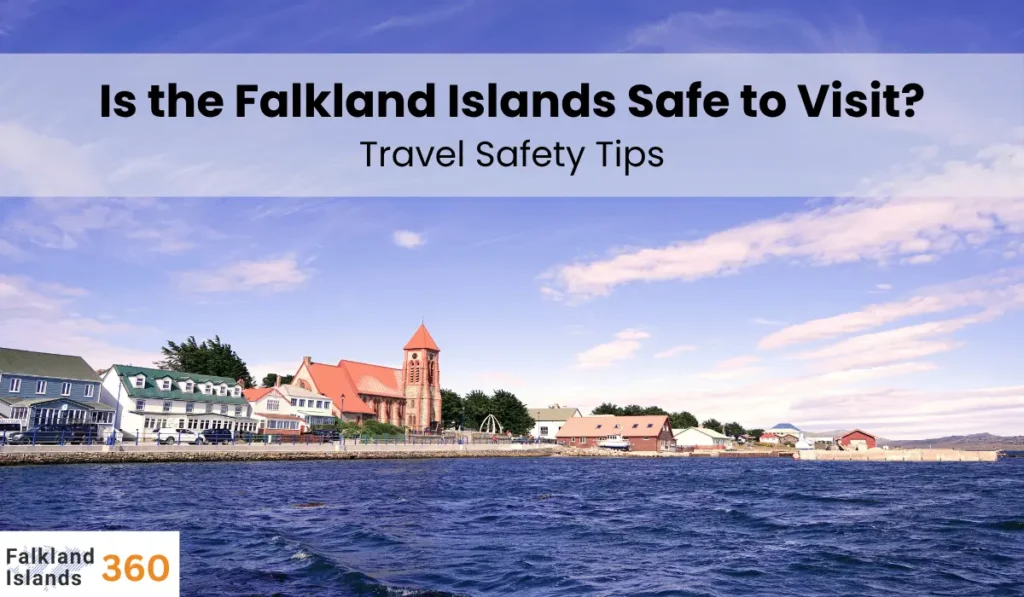Imagine sailing into a pristine South Atlantic archipelago where curious penguins waddle along sandy shores and vast landscapes stretch to the horizon. The 22 reasons to cruise the Falkland Islands will convince any nature lover, history buff, or adventure traveler that this remote British overseas territory belongs on your bucket list.
This sun-bleached gem boasts untamed scenery, incredible wildlife encounters and a unique mix of island and British culture that’s hard to find anywhere else. Whether you’re on a rugged expedition ship or a luxury liner, a Falklands cruise delivers wildlife-packed shore excursions, dramatic vistas and a warm islander welcome, all in easy-to-read, bite-sized adventures.
22 Reasons to Cruise the Falkland Islands
1. Penguin Paradise: The Falklands host five penguin species (King, Gentoo, Rockhopper, Magellanic and even a few Macaroni) with over a million nesting here. Cruises stop at colonies (like Volunteer Point) where massive rookeries of Gentoo and King penguins await your binoculars.
2. Iconic Wildlife: Beyond penguins, these islands teem with birds and mammals. You’ll likely spot elephant seals sparring on beaches, sea lions lounging by the shore and even playful dolphins or whales offshore. Sit quietly and watch a curious penguin or tussac bird approach you, these inquisitive island critters often come right up to visitors.
3. Spectacular Birding: Over 200 bird species breed here, including 70% of the world’s black‑browed albatross population. Experience epic seabird spectacles: cliffs teeming with albatross and cormorants, riverside penguin marches and coastal foraging geese and ducks. Photography buffs will love the sight of thousands of soaring albatross wings against blue skies.
4. Untouched Wilderness: With virtually no light pollution and very few people, the Falklands feel truly off the beaten path. Enjoy endless horizons of tussac grass, white-sand beaches and clear blue skies. Part of the adventure is simply absorbing the peace of island life, from walking on windswept beaches to watching a fiery southern sunset from deck.
5. Dramatic Scenery: Every shoreline on a Falklands cruise is unique: rolling emerald meadows flow into dazzling white beaches and rugged cliffs. Hikes or zodiac excursions deliver postcard-perfect panoramas. Don’t miss the wildflower-covered slopes of Cape Pembroke or the awe-inspiring limestone cliffs of Pebble Island, all postcard scenery best seen from sea or a short hike.
6. Joyful Journeys: Onboard expedition ships or cruise liners, every day at sea is an adventure. Sailing into the Falklands usually takes about 36 hours from Ushuaia, passing through the dramatic Southern Ocean. Modern ships have stabilisers to tame rough seas, so even “Drake Passages” let you rest between excursions. Inside, meet new friends as you swap wildlife sightings over dinner.
7. Shore Excursions Galore: Most cruises spend two full days exploring the Falklands. Onshore adventures can include guided wildlife walks, beach hikes and 4×4 trips. You can walk among gentoo penguins on the beach at Gypsy Cove, trek to windswept viewpoints on Saunders Island, or kayak around serene coves, all arranged by your ship’s expedition team. Small‑boat landings and zodiac cruises let you access pristine coves and islands no road can reach.
8. South Atlantic Sun: Unlike Antarctica cruises, a Falklands voyage basks in summer warmth. November–March brings long daylight and milder weather, perfect for wildlife viewing. (Evenings are soft and golden – ideal for photography.) If you time it right, you might even catch the aurora australis on crisp, dark nights in April–August.
9. Rich History: History buffs love the Falklands War relics and heritage. Explore Stanley’s Historic Dockyard Museum and war memorials, or visit battlefields on East and West Falkland (like Goose Green and Mount Harriet) under tour. The quaint Victorian architecture and English pubs of Stanley (complete with a whalebone arch and island newspaper office) add a quirky colonial charm.
10. Charming Stanley: The capital, Port Stanley, is an easy and delightful port of call. Its brightly painted cottages, flower-filled gardens and iconic Christ Church Cathedral evoke a tiny British village feel. Don’t miss Victory Green and the bear and whale-bone arch, or a pint at a local pub. The islanders are famously friendly, expect personal welcomes, homemade baking, and stories over tea (and pint!) when you stroll the harbour.
11. Volunteer Point: This special stop features one of the world’s largest King penguin colonies outside Antarctica. On a calm day, the cacophony of braying Kings, Gentoos and Magellanics on the snowy beach is unforgettable. Venture there on a cruise landing and witness these regal birds up close.
12. Sea Lion Island: A highlight on many cruise itineraries, Sea Lion Island is a wildlife reserve where you can walk among herds of southern sea lions and thousands of elephant seals. If you time your cruise right (November–December), you may even see killer whales hunting the seal pups in shallow water. With easy trails from a cozy lodge, wildlife views here can happen just outside your door.
13. Carcass Island: Another must-visit is Carcass Island, a sheep farm island turned bird sanctuary. It’s home to nesting Magellanic and Gentoo penguins, curious tussac-birds and the endemic Cobb’s wren. With peaceful beaches and lush hillsides, a stroll from the settlement to Leopard Beach gives you a chance to spy shy black-necked swans and watch the mischievous “Johnny Rook” caracaras.
14. Amazing Beaches: Crystal-clear waters lap dozens of secluded beaches. Beachcombing at Grave Cove or Volunteer Point rewards birders with penguins and petrels, while sandy coves like Gypsy Cove near Stanley are perfect for a relaxing walk and a penguin picnic. The Falklands’ famous white sands are as inviting as any Caribbean isle, but with penguins, making each stop feel like a private retreat.
15. Hiking and Adventure: Active travelers can clamber up peaks like Mount Usborne or scramble across Cape Pembroke headland trails to enjoy sweeping sea views. Even easy walks yield treats: wildflower meadows, penguin crossings, seal haul-outs. No guidebook needed: the islands beckon you out to explore, from roadside footpaths on East Falkland to highland treks on Saunders or Weddell Islands. Every vista is reward enough.
16. Marine Mammal Magic: The Falklands’ seas are alive with life. Aside from seals and sea lions onshore, watch for orcas and dolphins playing in the waves. In autumn (March–April) whale migration peaks – spot southern right, humpback or even rare sei whales on Zodiac cruises. Whale-watching boats may accompany you around Coffin’s Harbour or along Elephant Beach at Pebble Island, where beluga-like blows occasionally break the horizon.
17. Birdwatcher’s Paradise: If birdwatching is your passion, the Falklands are unbeatable. Thick seabird colonies and rare songbirds hide in every bay and bush. Cruise landings at West Point Island or Bleaker Island put you amidst giant albatross colonies. Offshore, Petrels and Sooty Shearwaters dart. On land, look for tiny endemic Cobb’s wrens in tussac grass. Even the common steamer ducks are a riot of color on lagoon edges – birders should bring binoculars for this flying safari.
18. Friendly Local Culture: Islanders celebrate both British tradition and island self-reliance. Enjoy hearty home-cooked meals, local jams and treats ashore, and hear tales of sheep-farming and Falklands life. By the time you depart Stanley, you may even pick up a straw lobster pot hat or Falklands Tourism souvenir. Many travelers recall fondly sitting in a village pub or island kitchen, mug of tea in hand, listening to folk music – the warmest welcome imaginable on a cruise.
19. Unique Flora: The islands aren’t just about animals. Walk among tussock grass so tall it obscures a person, and step carefully to avoid rare Falklands Springflowers in bloom. Over 250 flowering plants live here, including vivid yellow orchids and an elusive violet on Sea Lion Island. The contrast of colorful blossoms against rolling green hillsides feels surprisingly tropical for such a southern locale.
20. Clear Skies and Clean Air: Far from smog and city lights, the Falklands skies are impossibly clear. Bird and wildlife sightings stand out against brilliant blues and whites. At night, the Milky Way reigns supreme – and in winter, Aurora Australis (the southern lights) can dance overhead. This pure environment makes the cruise experience feel like true escape, reconnecting you with the raw beauty of nature.
21. Photographer’s Dream: With every view so dramatic, a Falklands cruise is a lens-lover’s dream. From the playful penguins and vividly colored uplands to golden sunsets over Stanley Harbour, every moment is postcard-worthy. Cruise experts even schedule landings at dawn or dusk when light is soft. Beginners and pros alike will fill memory cards capturing frolicking sea lions, jaw-dropping landscapes and iconic wildlife – pictures you’ll treasure long after the trip.
22. Once-in-a-Lifetime Adventure: Finally, the Falklands are simply unlike anywhere else on earth. Few places combine sub-Antarctic wildlife, British-flavored history, and raw natural beauty as the Falklands do. Each day of a cruise brings something new – a surprise bird, a chilling breech of a whale, or a handshake from a local – making every moment memorable. If you’ve ever dreamed of adventure and authenticity, 22 reasons to cruise the Falklands are waiting to sweep you off your feet.
How to Get to the Falklands
Getting to the Falklands is easier than you might think. Many cruise travelers depart from Ushuaia, Argentina, for a 36-hour voyage northward through the Southern Ocean. Alternatively, you can fly. Latam Airlines (Chile) runs weekly flights from Punta Arenas to Mount Pleasant (near Stanley), cutting sea time dramatically. The UK also operates a twice-weekly service from RAF Brize Norton (with a refueling stop), allowing British travelers to reach Stanley directly.
Whatever the mode, most arrivals (by cruise or flight) end at Mount Pleasant Airport, from where a bus or transfer takes you to Stanley. In cruise season (November–March), over 40 expedition ships include the Falklands on their itineraries, so booking a voyage is also a straightforward way to visit these islands.
When to Visit Falkland Islands
The best time to visit the Falklands is during their spring and summer, roughly November through March. This period brings the longest days, milder temperatures and maximum wildlife activity. Most migratory birds (like albatrosses and rockhopper penguins) arrive to breed, and whale migrations peak in late summer.
Even the island gardens burst into color with native flowers. Winter (June–August) is colder and windier, but also quieter; it’s when you might glimpse the Southern Lights dancing overhead if you don warm layers. Note that Falklands weather can change rapidly any time of year – packing waterproof layers and sturdy boots is a good idea. Although it can be brisk, cruises and flights operate year-round, and the islands rarely get too crowded, even in peak season.
Top Things to Do and Local Attractions of Falkland Islands
Explore Stanley. The tiny capital, Port Stanley, is brimming with charm and sights. Stroll past pastel houses to the whalebone arch on Victory Green, visit the historic Dockyard Museum (filled with maritime and natural history) and climb up to the pretty Christ Church Cathedral for harbor views.
History fans shouldn’t miss the Liberation Memorial and wartime sites around town. When cruise ships dock, local guides offer Stanley walking tours or vehicle tours covering all points of interest, from Victory Green to Kay’s Gnome Garden (yes, that exists!). Stanley’s cafes and pubs make a great pitstop – try a local lamb pie or a smooth Falklands ale while taking in the island hospitality.
Wildlife excursions. All island cruises include guided nature landings. You might find yourself watching elephant seals at Sea Lion Island, photographing penguins at Volunteer Point, or whale-watching off Coffin’s Harbour. Birdwatchers can look for unique species on islands like Carcass or West Point. Many tours let you approach wildlife on foot – in one moment you’re walking along a beach, and the next a curious gentoo has waddled right up to you. On some islands, penguin rookeries are so open that these birds may chatter at you from just a few feet away. These unforgettable encounters make every cruise stop thrilling.
Scenic walks and hikes. Beyond the beaches, the Falklands offer excellent hiking. Follow trails around Gypsy Cove for coastal panoramas or climb steep paths to viewpoints like Sparrow Cove. The legendary coastal hike at Gypsy Cove (near Stanley) rewards walkers with sights of white beaches and nesting gentoo penguins. On larger islands like Saunders or West Falkland, you can take longer treks (with guides) to see dramatic cliffs and moorlands. Remember that weather can be windy; local guides are experts at planning routes for safety and maximum views. Wherever you go, each trail reveals a new wildlife spectacle – be it a soaring albatross or a huddling Magellanic penguin pair.
Historic sites. Discover the Falklands’ layered past. Visit old sheep farms where pioneer cottages and corrals survive, or stop at one of the rustic island churches. The small Falkland Islands Museum in Stanley is a treasure trove for history buffs, covering settler life through the 1982 conflict. For war history enthusiasts, many cruise itineraries include battlefield tours on East and West Falkland: sites like Goose Green or Mount Longdon have memorials and crashed planes preserved in the wild. Combined with the wildlife and culture, this mix of natural and historical attractions keeps every traveler engaged.
Conclusion
All 22 reasons to cruise the Falklands combine into a once-in-a-lifetime adventure. From the moment you feel the salty spray on deck and glance at tufts of Gentoo penguins on the shore, you’ll know it was worth the journey. These islands deliver raw nature, fascinating history and friendly islander culture in equal measure. Whether you’re a seasoned polar explorer or a first-time cruiser, the Falklands will surprise and enchant you.
So why wait? Start planning your trip now – the South Atlantic’s best-kept secret is ready to wow you with penguins, albatrosses, wild beaches and 22 unbeatable reasons to set sail to the Falkland Islands.
FAQ
Do I need a visa to cruise to the Falklands?
Most cruise passengers will get their passport stamped automatically at Stanley and do not need a separate visa. If you’re flying or planning independent travel on the islands, citizens of many countries (USA, EU, Australia, etc.) enjoy visa-free entry for short stays. Always check the latest Falklands Government advice before traveling.
When is the best time to cruise the Falklands?
The peak cruise season is the Southern Hemisphere summer (November–March). This is when wildlife is most active (penguin chicks, nesting birds) and days are longest. Spring (October–November) and autumn (March) can still be excellent, with fewer crowds. Winter brings harsher weather but unique experiences like the aurora; however, cruises are rare then.
How do I actually get there?
Aside from sailing from Ushuaia, you can fly into Stanley’s Mount Pleasant Airport. A weekly LATAM flight links Punta Arenas (Chile) to Stanley, and twice-weekly RAF flights run from the UK. If you arrive by air, transfers shuttle you into Stanley. If you’re on a cruise, your ship will dock at the Stanley pier and excursions depart from there.
What wildlife can I expect on a Falklands cruise?
Expect spectacular wildlife. The Falklands are the place for penguins (five species), along with seabirds (albatross, cormorants, terns, skuas). Marine mammals include elephant seals, sea lions, fur seals and dolphins. In spring and summer, whales (like humpback and right whales) pass through. Every island stop is a chance to see a new animal in its natural habitat.
Are the seas rough? Will I get seasick?
The islands lie north of the Drake Passage, but the Southern Ocean is always changeable. Modern expedition cruise ships have stabilisers to significantly reduce roll in rough water. Captains also plan routes to avoid the worst weather when possible. If you tend to seasickness, choosing a larger ship and bringing remedies is wise, but most travelers do fine on these voyages.




